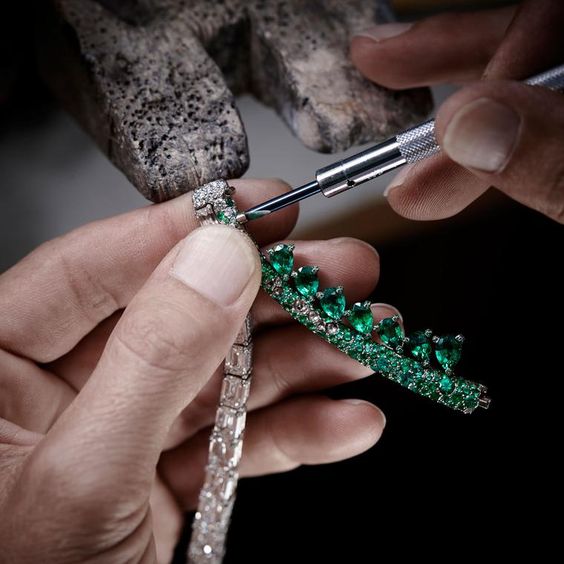How to know if my Colombian emerald was treated
Colombian emeralds are recognized all over the world for their dazzling green color and natural beauty. These gems are appreciated not only for their aesthetic value, but also for their history and tradition in the culture of jewelry.
At present, however, it is important to note that some emeralds may have undergone treatments to improve their appearance. Fortunately, there are several simple techniques that consumers can use to identify possible treatments in Colombian emeralds with the naked eye.
Treatments in Colombian emeralds
There are several treatments used in the gem industry to improve the appearance and quality of emeralds. These treatments seek to highlight the color, clarity and durability of stones. Some of the most common treatments for emeralds include:
1. Cedar oil:
This is one of the most traditional and widely accepted treatments for emeralds. It consists of impregnating the stone with cedar oil or other similar substances. The oil penetrates the cracks and internal emerald fractures, improving its appearance by reducing the visibility of the inclusions and increasing the brightness. Eventually, this oil can dry or escape, so emerald may need to be reacclaimed.
2. Oil with Resins:
In addition to cedar oil, transparent polymer resins can be used to fill the inclusions and fractures in the emeralds. This can improve the appearance and clarity of the stone. However, this treatment is less common than cedar oil because resins may be less stable over time.
3. Treatments with Glass:
Some emeralds may undergo glass treatments. In this process, inclusions and cavities are filled with melted glass or transparent epoxy resins. This treatment can significantly improve the clarity and brightness of the stone, but is less durable than other methods and can negatively affect its long-term value.
4. Improvement of Clarity by Warming:
Some emeralds can be subjected to warming processes to reduce or eliminate internal inclusions. This treatment is less common in emeralds than in other precious stones, such as sapphires and rubies. Warming can improve the clarity of the stone, but if it is done excessively, it can alter the color and internal structure of the emerald.
5. Dye and Tesed with Oil:
Some lower quality emeralds can be dyed to improve their color. This involves introducing dyes to alter the appearance of the stone. Then, cedar oil can be applied to seal the dye. This treatment is less desirable and can negatively affect the authenticity and value of emerald.
Importantly, the gem industry has ethical regulations and standards for the dissemination of treatments. Sellers and traders should provide accurate and transparent information on any treatment that has been applied to an emerald. When buying an emerald, especially a higher value, it is always advisable to obtain a certificate of authenticity issued by a renowned gemology laboratory to know the details about possible treatments.
Step to Step: Identify treatments in your emerald
1. Observation of colour:
Color is one of the most distinctive features of Colombian emeralds. These natural gems usually showcase a deep, vibrant green. When observing an emerald, pay attention to the uniformity of color. If you notice stains, lighter areas of colour or irregularities in the tone, the gem may have been treated to improve its color. Natural emeralds can also have internal inclusions and features, which is normal and can contribute to their authenticity.
2. Reflections and brightness:
The authentic Colombian emeralds have a unique brightness and glow. If you notice that the gem looks excessively bright, with flashes of spectrum colors, it could be an indication that it has undergone oil or other agents treatments to improve its clarity and brightness. If the emerald seems too clean - and does not show any internal features, it may have been treated to hide its natural inclusions.
3. Optical effects:
Some emeralds may show optical effects that suggest the presence of treatments. For example, if the gem shows a cat's eye (a luminescent line effect in the shape of a cat's eye), it is likely that it has been treated with epoxy resin to fill cracks and improve appearance. Similarly, if you notice a flashing star when light affects emerald from certain angles, this could be an indicative of treatment.
4. Inspection of inclusions:
Inclusions are internal characteristics commonly found in natural emeralds. Some inclusions are identifiable features of Colombian mines, but others may indicate that the gem has been treated. If you look at inclusions that appear to be stuffed with substances like oil, resin or glass, the emerald is likely to have been treated to improve its appearance. Carefully inspect the gem with a magnifying glass to detect these signals.
5. Certification and origin:
An effective way to make sure you're acquiring an authentic and untreated Colombian emerald is to get a certificate of authenticity issued by a renowned entity in the gem industry. In addition, it investigates the origin of the gem and the renowned history of the source. Colombian emeralds from recognized mines are less likely to have undergone treatment.
6. Consult with an Expert: If you have doubts about the authenticity or possible treatments of a Colombian emerald, it is best to consult with a gemology expert. Trained gemologists have the experience and tools to make an accurate stone assessment and determine whether it has been treated in any way.
Paula A. Bonilla
Social communicator and journalist from Sergio Arboleda University in Colombia. She is also a jeweler and is passionate about constantly learning about precious gems and national high jewelry.
Currently, she is working for one of Bogotá's most important jewelry stores, Emerald by Love. This jewelry store has over 40 years of experience and has 2 physical branches in the capital city of Colombia, located in the city center.


